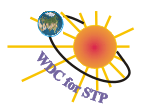|
|
|
Dst index of Geomagnetic Activity
The Dst index of geomagnetic activity at low latitudes is a measure of the variation of the field
due to ring currents arising in the magnetosphere during magnetic storms (Disturbance Storm Time). On the earth's surface,
the effect of ring currents is affected by a decrease in the horizontal component Н of the magnetic field with
a maximum decrease at low latitudes.
The Dst index was proposed by Sugiura (1964) to measure the magnitude of the current which produces the axially symmetric
disturbance field. It is derived from geomagnetic field variations in the H component measured at 4 stations at low latitude:
Kakioka (36.23°, 140.19°); Honolulu (21.32°, 202.00°); San Juan (18.11°, 293.85°); Hermanus (-34.43°, 19.23°).
The Dst index is calculated as the average value in the hour interval of the perturbation of the horizontal component
of the Earth's magnetic field, measured from a quiet level.
The Dst index is calculated and made available by the
World Data Center for Geomagnetism, Kyoto
from data collected at magnetic observatories.
Download a continuous time series of definitive hourly Dst index values since 1957
in WDC format.
Download a continuous time series of definitive hourly Dst index values since 1957
in IAGA2002 format.
Citation: World Data Center for Geomagnetism, Kyoto, Nose M., Iyemori T., Sugiura M. and Kamei T. (2015) -
Geomagnetic Dst index, doi:10.17593/14515-74000.
WDC for STP, Moscow is grateful to the ISGI Collaborating Institute
World Data Center for Geomagnetism, Kyoto, the
INTERMAGNET network and
International Service of Geomagnetic Indices – ISGI (isgi.unistra.fr).
Using the data, please be sure to indicate the above organizations according to the following
template.
Reference: Sugiura, M. (1964) - Hourly values of equatorial Dst for the IGY, Ann. Int. Geophys. Year, 35, 9, Pergamon Press, Oxford.
How to Cite Datasets:
Ball, A. and M. Duke [2011], How to cite datasets and link to publications, DCC How-to Guides, Edinburgh: Digital Curation Centre.
|
|
|



